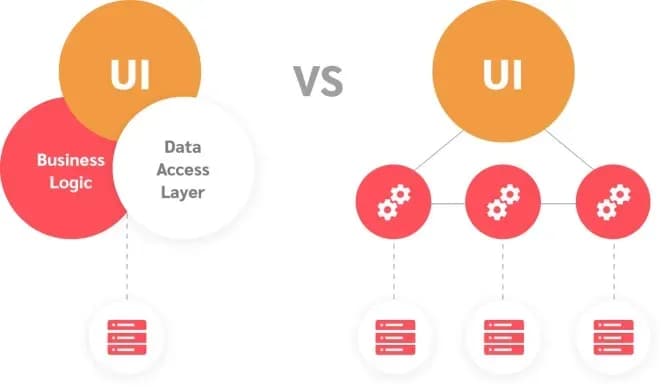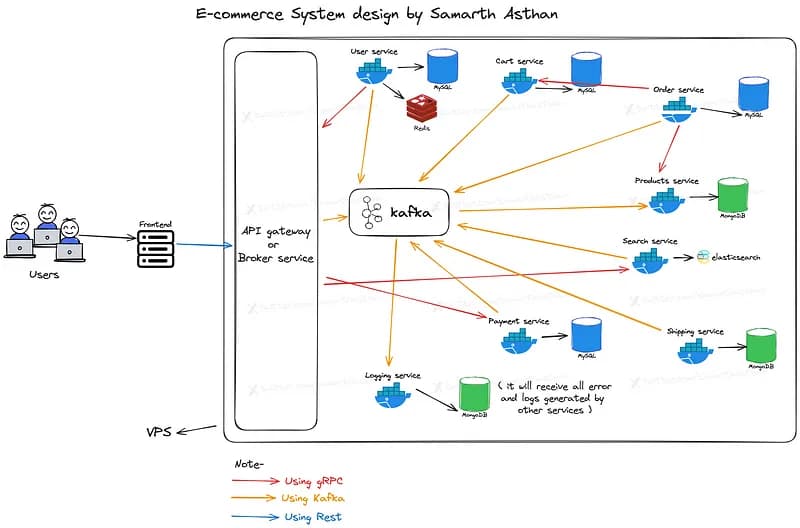Hey everyone! I’m Samarth Asthan, a 3rd-year computer science student, and I’m new to the world of system design. But, I’m excited to share what I’ve learned about micro-services and how they play a crucial role in building robust and scalable e-commerce platforms.
Table of contents
Open Table of contents
What are Monolithic and Micro-services?

Imagine a big machine running all code on one machine, making it challenging to scale and address issues.
On the other hand, micro-services run multiple small backends on various machines, aiding scalability and easy management.
Before going deep dive into design, let’s understand function and non-functional requirements for our design-
Functional requirements:
- User service: Handles authentication, authorization, and user information tracking.
- Product service: Manages inventory, stock, and other product-related tasks.
- Search service: Facilitates product searching based on categories and other criteria.
- Cart service: Manages cart-related actions like adding to cart, moving to wishlist, etc.
- Order service: Crucial for order processing, distinct from other services for reliability.
- Shipping service: Tracks order status, cancellations, refunds, and related functionalities.
- Payment service: Acts as a liaison with external payment gateway providers, ensuring smooth transactions on our platform.
- Logging service: Vital for identifying and addressing issues in our services; maintaining detailed logs is crucial for the smooth operation of our platform.
Non-functional requirements:
- Scale: We can add or remove blocks as needed to handle more customers or traffic.
- Availability: If one block goes down, the others can still work.
- Security: We can focus on securing each block individually.
Design:

User flow and micro-service communication:
1. Front-end:
- Hosted separately on a platform like AWS EC2 or server-less AWS Lambda.
- Connects to the API Gateway using REST API calls.
2. API Gateway:
- Acts as a broker, routing requests to appropriate micro-services.
- Utilizes either Apache Kafka or gRPC for communication, depending on the functionality.
3. Micro-services:
- Each micro-service performs a specific task, like product management or order processing.
- Communicate with each other using gRPC or Apache Kafka, based on the request type.
- Produce and push all logs and errors to the Apache Kafka queue.
4. Logging Service:
- Consumes messages from the “logging” topic of the Apache Kafka queue.
- Handles and processes all logs and errors received from micro-services.
Overall communication flow:
- User interacts with the front-end website.
- Front-end sends requests to the API Gateway.
- API Gateway routes the request to the appropriate micro-service(s).
- Micro-services communicate with each other as needed using gRPC or Kafka.
- All micro-services send logs and errors to the Kafka queue.
- The logging service processes and analyzes the logs and errors.
Conclusion
I’m still learning about system design, but hopefully this basic idea gives you a good starting point for understanding how micro-services can help you build a better e-commerce platform.
This is just my current understanding, and I got some ideas from other sources too. There’s still a lot to learn and improve, but I’m excited about the possibilities of micro-services for e-commerce.
Stay tuned for more blog posts where we’ll talk more about individual micro-services, how they talk to each other, and how to build them!
Follow me on Twitter for more back-end content! 🚀
🚀 Just did some quick math on server performance! 💻✨ A server with 36 cores and 256GB RAM can handle around 360 requests per second for CPU-bound tasks and a whopping 546,133 requests per second for memory-bound tasks. Mix 'em up, and you get about 270,000 requests per second!… pic.twitter.com/m15eENhtF5
— Samarth Asthan (@samarthasthan) December 3, 2023